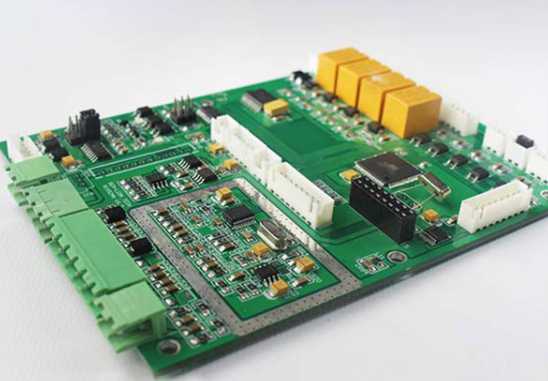
1. Thermogravimetric Analysis (TGA)
Similarly, the template is coated with a new HTOSP film, an industry-standard OSP film, and another industrial OSP film. Scrape approximately 17.0mg of OSP film from the copper sheet as a material test sample. The sample and film should not be subjected to any lead-free reflux treatment before TGA testing. TGA tests were performed under nitrogen protection using TA Instruments 2950TA. The operating temperature was kept at room temperature for 15 minutes and then increased to 700℃ at a rate of 10℃ / min.

2. Photoelectron spectroscopy (XPS)
Photoelectron spectroscopy (XPS), also known as chemical analytical electron spectroscopy (ESCA), is a chemical surface analysis method. XPS can measure the chemical composition of the coating surface at 10nm. HTOSP film and industry standard OSP film were applied to the copper plate and then five lead-free reflow cycles were performed. HTOSP films were analyzed by XPS before and after reflux treatment. Industry-standard OSP films after 5 lead-free reflow were also analyzed by XPS using a VGESCALABMarkII instrument.
3. Through hole weldability test
The through hole weldability test was performed using a solderability test plate (STVs). A total of 10 solderability test plate STV arrays (each with 4 STVs) were coated with a film thickness of about 0.35μm, with 5 STV arrays coated with HTOSP films and 5 STV arrays coated with industry-standard OSP films. The coated STVs are then subjected to a series of high-temperature, lead-free reflux treatments in a solder paste reflux furnace. Each test condition consisted of 0, 1, 3, 5, or 7 consecutive reflow. Each membrane will have 4 STVs for each reflux test condition. After the reflux treatment process, all STVs are treated with high temperature and lead-free wave welding. Through hole weldability can be determined by checking each STV and calculating the number of correctly filled through holes. The standard for through hole acceptance is that the filler must be filled to the top of the plated through hole or the upper edge of the through hole.
Each STV has 1196 through holes
10 milholes - Fourgrids, 100 holeseachgridsquareandrou ndpads
20 milholes - Fourgrids, 100 holeseachgridsquareandrou ndpads
30 milholes - Fourgrids, 100 holeseachgridsquareandrou ndpads
5. Test weldability by tin-dipping balance
The solderability of O S P film can also be determined by a tin balance test. HTOS P film was coated on the test sample of tin-stained balance. After 7 lead-free reflux, Tpeak=262℃. Reflux is processed by BTUTRS combined with IR/convection furnace. The tin-stained balance test was performed in accordance with IPC/EIAJ-STD-003A Part 4.3.1.4, using the "RoboticProcessSystems" automated tin-stained balance tester, EF-8000 flux, non-clean flux, and SAC305 alloy solder.
Test of welding bonding force
The welding bonding force can be measured by shear force. The BGA pad test plate (diameter 0.76mm) was coated with HTOSP film with the thickness of 0.25 and 0.48μm, respectively, and subjected to three lead-free reflux treatments at a maximum temperature of 262℃. Solder to pad with matching paste. Solder ball is SAC305 alloy (diameter 0.76mm). DagePC-400 adhesion tester was used for shear test at 200μm/see.
Results and discussion
1. Gas chromatography-mass spectrometry analysis
Gas chromatography-mass spectrometry can be used to detect the volatility of organic components in OSP films. Commercially different OSP products contain different azole compounds including imidazoles and benzimidazole. Alkyl benzimidazole for HTOSP membranes, alkyl benzimidazole for standard OSP membranes, and phenyl imidazole for other OSP membranes evaporate when heated in a gas chromatography column. Because organometallic polymers do not evaporate, the azoles polymerized with metals cannot be detected by gas chromatography-mass spectrometry. Therefore, GC-MS can only detect zoles and other small molecules that do not react with metals. Usually under the same heating and airflow conditions as in a gas column, the less volatile small molecules retain longer.
The residence time of alkyl benzimidazole for standard OSP membrane and phenyl imidazole for another OSP membrane was 19.0 min, indicating that HT alkyl benzimidazole had the lowest volatility. Among the three OSP membranes, HTOSP membrane contained the least impurity. Organic impurities in OSP films can also affect the solderability of the films during reflux treatment and cause discoloration.
KojiSaeki[5] reported that due to the lower density of copper ions on the surface of OSP film, the polymerization reaction on the surface was weaker than that at the bottom of the film. We suggest that there are still unreacted azole compounds in the surface layer of OSP membrane. During reflux treatment, more copper ions move from the bottom to the top layer of the membrane, providing an opportunity to react with the unreacted azole compounds on the top layer, thereby preventing copper oxidation. The alkyl benzimidazol-HT used in HTOSP membranes is less volatile and therefore more likely to react with copper ions moving from the lower layers to the surface, thereby reducing copper oxidation during the reflux process. XPS can show the transfer of copper ions from the lower layer to the surface layer, thereby reducing the oxidation of copper during the reflux process.







